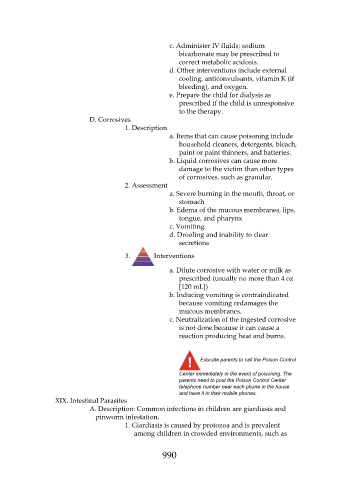Page 990 - Saunders Comprehensive Review For NCLEX-RN
P. 990
c. Administer IV fluids; sodium
bicarbonate may be prescribed to
correct metabolic acidosis.
d. Other interventions include external
cooling, anticonvulsants, vitamin K (if
bleeding), and oxygen.
e. Prepare the child for dialysis as
prescribed if the child is unresponsive
to the therapy.
D. Corrosives
1. Description
a. Items that can cause poisoning include
household cleaners, detergents, bleach,
paint or paint thinners, and batteries.
b. Liquid corrosives can cause more
damage to the victim than other types
of corrosives, such as granular.
2. Assessment
a. Severe burning in the mouth, throat, or
stomach
b. Edema of the mucous membranes, lips,
tongue, and pharynx
c. Vomiting
d. Drooling and inability to clear
secretions
3. Interventions
a. Dilute corrosive with water or milk as
prescribed (usually no more than 4 oz
[120 mL])
b. Inducing vomiting is contraindicated
because vomiting redamages the
mucous membranes.
c. Neutralization of the ingested corrosive
is not done because it can cause a
reaction producing heat and burns.
Educate parents to call the Poison Control
Center immediately in the event of poisoning. The
parents need to post the Poison Control Center
telephone number near each phone in the house
and have it in their mobile phones.
XIX. Intestinal Parasites
A. Description: Common infections in children are giardiasis and
pinworm infestation.
1. Giardiasis is caused by protozoa and is prevalent
among children in crowded environments, such as
990

